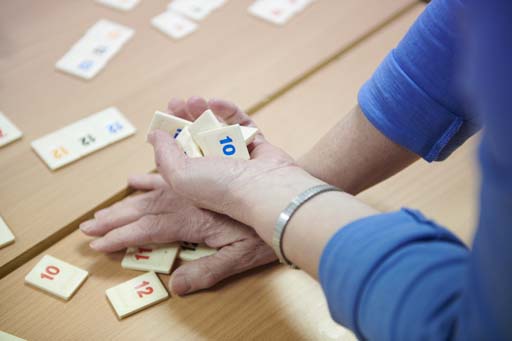4.9 A case study
Case Study 4.1 Caz’s impulsive compulsive crafts story
Some Parkinson's medication can cause side effects known as impulsive and compulsive behaviours. Here we meet Caz, who shares how an obsession with crafts affected her.
"It took over my life," explains Caz. "Whether it was a dress I was making or a painting I was doing, I'd be up all night working on it. My husband Steve would wake up at 3am and say 'come on, come to bed – you must be tired'. But I couldn't stop. When it was at its worst, I was up for 3 days solid with no sleep."
Caz was diagnosed with Parkinson's aged 46, after 4 years of uncertainty about her symptoms. She explains that it was a type of drug called ropinirole that was the cause of her obsessive behaviour.
Caz explains that the medication changed her life dramatically at first. “I had more energy and my symptoms really improved. I’d been so self-conscious going out, being stared at all the time. I finally felt like I could live my life again.”
"My main hobby was making crafts, so I decided I would make purses. "I started making other things – bags, hats, jewellery. I calculated the costs so I could invest in more materials to make more things, and in turn make more profit. I got such a buzz from it and it really gave me a sense of purpose."
Over a 2-year period, Caz's medication was gradually upped each time she saw a consultant, until eventually she was on 14mg of ropinirole. "I think the meds make you feel like you’re on a bit of a high,” she says. "I was becoming happier each day, and with that I started buying more and more things. I've always been a bit of a charity shop fan, and I'd started buying lots of clothes. I'd lost 4 stone so none of my old clothes fitted. I would buy a dress, then go back and buy another the day after. I was also buying an excessive amount of fabric to make things with and was staying up all night just to finish the dozens of craft projects I'd started."
Caz describes how by this point she'd started lying to her husband about her spending. "One day he asked me about some money and I said I'd spent it on a bill, when I'd actually spent it on more crafts and clothes. I was starting to spend £40, £70 a week, on all sorts of things – silly things I didn't need – which of course started to add up. I thought, ‘what am I doing to this man who cares for me so much?'"
Not only had Caz's hobby turned into an obsession, but she’d started smoking again after 13 years of quitting. Caz eventually broke down, describing the moment she burst into tears when her husband came home. "I was in the loft hiding fabrics and I just couldn’t handle it anymore. I knew there was something wrong with me and that my behaviour wasn’t normal," she adds.
Her husband Steve phoned her Parkinson's nurse who visited the next morning. Almost immediately she explained that it was a side effect of the medication that was causing the problems and recommended that she change her medication. "On the day I was diagnosed the consultant had briefly mentioned side effects. But when you’re being told you have Parkinson’s you don’t really think too much about things like that as you’re trying to take everything else in."
Caz is keen to spread the word about her experience and feels strongly that people should be informed about side effects.
"People can feel ashamed. This is why I speak openly about it – I want to break that taboo. People shouldn't feel bad when it’s not their fault."
And how is Caz doing now? "Things have improved since. I take a lot of other Parkinson’s drugs to keep my symptoms at bay, and of course those come with other side effects. And some people point out that I still do crafts. But it's different, because I now know the difference between an obsession and a hobby."
Exercise 4.2
Work through the questions below – remember there may be more than one correct answer.
- Why is it important that people should be able to self-administer their medication where possible?
- Name one of the serious side effects of Parkinson’s medication being reduced or stopped abruptly.
- What tools are available to help people remember to take their medication?
- Name two of the drug types used in managing Parkinson’s.
- Describe what being ‘on’ and what being ‘off’ means for the person with Parkinson’s, and those around them.
- Describe three side effects of taking Parkinson’s drugs.
- What action should you take if you notice these side effects in a person with Parkinson’s?
- Name two of the drugs that can be harmful to people taking Parkinson’s medications.
Answer
- It is important that people can self-administer their medication where possible because they can then make sure they are taking their medication on time.The timing of medication is crucial to people living with the condition. If people are unable to take their medication on time, their Parkinson’s symptoms become uncontrolled. This increases their care needs considerably. If a person with Parkinson’s goes into hospital or respite, it is important that they are allowed to continue their medication regimes.
- Serious side effects include neuroleptic malignant syndrome or dopamine agonist withdrawal syndrome (DAWS).
- Tools include pill timers, pill boxes with ringtone reminders, alarms on mobile phones, etc.
- Drug types used in managing Parkinson’s include levodopa, dopamine agonists, MA-OB inhibitors, COMT inhibitors, glutamate antagonists and anticholinergics.
- Being switched ‘on’ means the person’s symptoms are controlled; they are able to function well, move around and manage everyday tasks themselves within their own capabilities. Being switched ‘off’ means their symptoms are not under control; they may be unable to move or speak and can become quite distressed.
- Side effects include nausea and vomiting, confusion, hallucinations, sleepiness and dyskinesia, and impulsive and compulsive behaviour. To check other side effects that you may have known about but are not mentioned in the workbooks, see the Drug treatments for Parkinson’s booklet.
- Make sure that the person with Parkinson’s sees their specialist or Parkinson’s nurse – they may be able to alter the person’s drugs regime to combat these side effects.
- Drugs that can be harmful to people taking Parkinson’s medications include:
- chlorpromazine (Largactil)
- fluphenazine (Modecate)
- perphenazine (Fentazin/Triptafin)
- trifluoperazine (Stelazine)
- flupenthixol (Fluanxol/Depixol)
- haloperidol (Serenace/Haldol)
- metoclopramide (Maxalon)
- prochlorperazine (Stemetil)
4.8 What are the main issues related to Parkinson’s medication?

